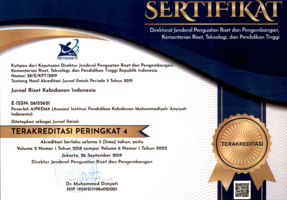Title:
Hubungan kontrasepsi hormonal dengan siklus menstruasi
Author:
Abstract
Latar belakang: Kontrasepsi hormonal merupakan kontrasepsi yang mengandung hormon progestin saja maupun kombinasi dengan kandungan estrogen dan progestin. Metode kontrasepsi hormonal memiliki banyak efek samping, salah satunya gangguan siklus menstruasi, metrorhagia, menorhagia. Akseptor sering menghentikan kontrasepsi hormonal karena gangguan siklus menstruasi. Tujuan penelitian: Diketahuinya hubungan kontrasepsi hormonal dengan siklus menstruasi. Metode : Penelitian ini merupakan penelitian deskriptif kuantitatif dengan pendekatan cross sectional. Populasi yang digunakan adalah 80 ibu akseptor kontrasepsi hormonal, dimana pengambilan sampel secara total sampling. Analisa bivariat dengan uji chi-square (α) ≤ 0,05 dan Prevalence Ratio (PR). Hasil: Sebagian besar responden kontrasepsi hormonal progestin 36 (85,7 %) dan lebih dari setengah responden kontrasepsi hormonal kombinasi 20 (52,6 %) mengalami ketidaknormalan siklus menstruasi. Hasil uji statistik chi square menunjukkan bahwa ada hubungan antara kontrasepsi hormonal dengan siklus menstruasi (p=0,003<0,05) dan PR 1,629 (CI=1,176-2,256) Simpulan: Terdapat hubungan antara penggunaan alat kontrasepsi hormonal dengan siklus menstruasi, akseptor kontrasepsi hormonal progestin beresiko 1,6 kali lebih besar mengalami ketidaknormalan siklus menstruasi dibanding akseptor kontrasepsi hormonal kombinasi.
Background: Hormonal contraception is a contraceptive containing progestin-only hormones or a combination of estrogen and progestin content. Hormonal contraceptive methods have many side effects, one of which is menstrual cycle disorders, metrorhagia, menorhagia. Acceptors often stop hormonal contraception because of menstrual cycle disorders. Objectives: Knowed the relationship of hormonal contraception with the menstrual cycle. Method: This study is a quantitative descriptive study with cross sectional approach. The population used was 80 mothers of hormonal contraceptive acceptors, where total sampling was taken. Bivariate analysis with chi-square test (α) ≤ 0.05 and Prevalence Ratio (PR). Results: Most respondents of progestin hormonal contraception 36 (85.7%) and more than half of the respondents in combination hormonal contraception 20 (52.6%) experienced abnormal menstrual cycles. Chi square statistical test results show that there is a relationship between hormonal contraception with the menstrual cycle (p = 0.003 <0.05) and PR 1.629 (CI = 1,176-2,256) Conclusion: There is a relationship between the use of hormonal contraception with the menstrual cycle, Progestin hormonal contraceptive acceptors are 1.6 times more likely to experience abnormal menstrual cycles than combined hormonal contraceptive acceptors.
Keywords
Full Text:
PDFReferences
Abd Elwadood, A., Sayed, G., El-Snosy, E., & Zahran, K. (2019). The effect of hormonal contraception and intrauterine device on the pattern of menstrual cycle. Journal of Current Medical Research and Practice, 4(2), 225. https://doi.org/10.4103/jcmrp.jcmrp_28_19
Blumenthal, P. D., & Edelman, A. (2008). Hormonal contraception. Obstetrics & Gynecology, 112(3), 670–684.
Carsel, S. (2018). Metodologi Penelitian Kesehatan dan Pendidikan (Cetakan 1). Penebar Media Pustaka.
Ekasari, W. U., & Risnawati, R. (2017). LAMA PEMAKAIAN DMPA DENGAN GANGGUAN MENSTRUASI PADA AKSEPTOR KB DMPA. Jurnal Kesehatan Ibu Dan Anak Akademi Kebidanan An-Nur, 1(1).
Faculty of Sexual and Reproductive Healthcare. (2015). Problematic bleeding with hormonal contraception. Development, September.
Feisullin, K., & Westhoff, C. (2010). Contraception. Principles of Gender-Specific Medicine, 357–365. https://doi.org/10.1016/B978-0-12-374271-1.00033-2
Fruzzetti, F., Perini, D., Fornaciari, L., Russo, M., Bucci, F., & Gadducci, A. (2016). Discontinuation of modern hormonal contraceptives: an Italian survey. The European Journal of Contraception & Reproductive Health Care, 21(6), 449–454.
Harismi, A. (2019). Tak Hamil, tapi Terlambat Menstruasi? 7 Hal Ini Mungkin Penyebabnya. https://www.sehatq.com/artikel/tak-hamil-tapi-terlambat-menstruasi-7-hal-ini-mungkin-jadi-penyebabnya
Kementerian Kesehatan RI. (2019). Profil Kesehatan Indonesia 2018.
Lopez, L. M., Grey, T. W., Stuebe, A. M., Chen, M., Truitt, S. T., & Gallo, M. F. (2015). Combined hormonal versus nonhormonal versus progestin‐only contraception in lactation. Cochrane Database of Systematic Reviews, 3.
Mohammed, N. F., & Abdel-Aleem, M. A. (2017). Effect of Contraceptive use on Menstrual Cycle Pattern among clients attending Family Planning Clinics at Assiut City. Assiut Scientific Nursing Journal, 5(10), 29–39.
Noviawati, D. (2011). Panduan lengkap pelayanan KB Terkini. Yogyakarta: Nuha Medika, 56–57.
Octasari, F., Sarumpaet, S. M., & Yusad, Y. (2014). Hubungan jenis dan lama penggunaan alat kontrasepsi hormonal terhadap gangguan menstruasi pada ibu PUS di Kelurahan Binjai Kecamatan Medan Denai Kota Medan Tahun 2014. Gizi, Kesehatan Reproduksi Dan Epidemiologi, 1(3).
Pratiwi, W. M., & Desy, E. (2017). Menikmati 9 Bulan Yang Menyenangkan. Buana Ilmu Populer Kelompok Gramedia.
Purwandari, E. S., & Setyowati, A. (2018). Correlation use of Injectable Contraceptive Types with Menstruation Pattern Changes in Contraception Acceptor. The 2nd Joint International Conferences, 2(2), 799–803.
Susanti, L. (2019). The Differences Between Hormonal Pills and Injection Contraception Adverse Effect: Pekanbaru Puskesmas Case Study. International Journal of Healthcare Research, 1(2), 68–71.
Veisi, F., & Zangeneh, M. (2013). Comparison of two different injectable contraceptive methods: Depo-medroxy progesterone acetate (DMPA) and cyclofem. Journal of Family & Reproductive Health, 7(3), 109.
Whitaker, A., & Gilliam, M. (2014). Contraception for adolescent and young adult women. In Contraception for Adolescent and Young Adult Women. https://doi.org/10.1007/978-1-4614-6579-9
WHO. (2010). Medical eligibility criteria for contraceptive use. World Health Organization.
Wijayanti, N., Thaweesit, S., & Sunpuwan, M. (2015). Contraceptive use among married adolescent women in Indonesia. Journal of Health Research, 29(5), 323–331.
DOI: https://doi.org/10.32536/jrki.v4i1.71
Article Metrics
Abstract view : 7860 timesPDF - 2568 times
Cited By
Refbacks
- There are currently no refbacks.
Copyright (c) 2020 Jurnal Riset Kebidanan Indonesia

This work is licensed under a Creative Commons Attribution-ShareAlike 4.0 International License.
Jurnal Riset Kebidanan Indonesia
Indexing by:
Diterbitkan oleh:
AIPKEMA (Asosiasi Institusi Pendidikan Kebidanan Muhammadiyah-'Aisyiyah Indonesia)
Universitas ‘Aisyiyah Yogyakarta, Jl. Siliwangi (Ring Road Barat) No. 63, Nogotirto, Gamping, Sleman, Yogyakarta 55292.
Telp. (0274) 4469199; CP: 081236093816; Email: aipkemajrki@gmail.com; dewik.2011@gmail.com

This work (Jurnal Riset Kebidanan Indonesia) is licensed under a Creative Commons Attribution-ShareAlike 4.0 International License.










 Abstract views : 7860
|
Abstract views : 7860
| PDF views : 2568
PDF views : 2568


